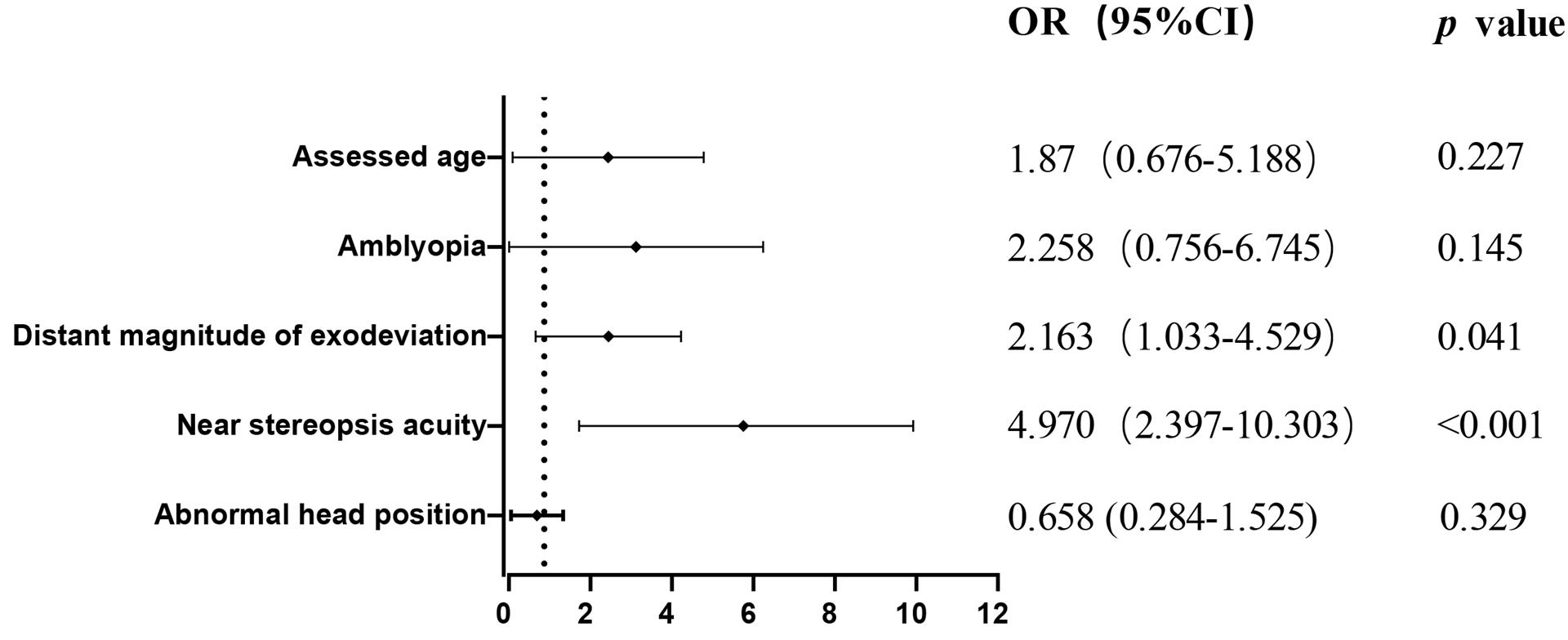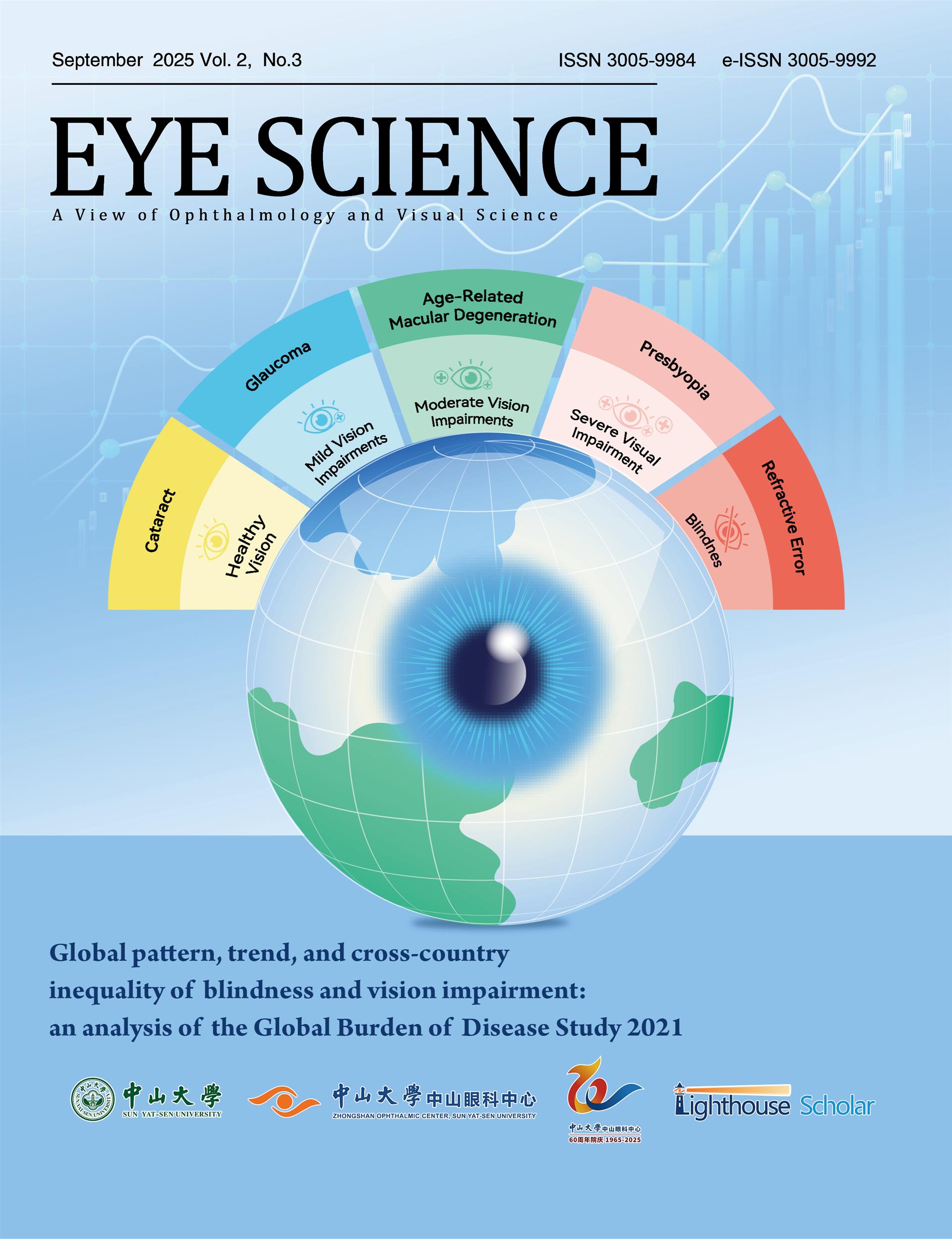1、Khorrami-Nejad M, Akbari MR, Kangari H, et al. Abnormal head posture in unilateral superior oblique palsy. J Binocul Vis Ocul Motil. 2021, 71(1): 16-23. DOI: 10.1080/2576117x.2020.1845561.Khorrami-Nejad M, Akbari MR, Kangari H, et al. Abnormal head posture in unilateral superior oblique palsy. J Binocul Vis Ocul Motil. 2021, 71(1): 16-23. DOI: 10.1080/2576117x.2020.1845561.
2、Tollefson MM, Mohney BG, Diehl NN, et al. Incidence and types of childhood hypertropia: a population-based study. Ophthalmology. 2006, 113(7): 1142-1145. DOI: 10.1016/j.ophtha.2006.01.038. Tollefson MM, Mohney BG, Diehl NN, et al. Incidence and types of childhood hypertropia: a population-based study. Ophthalmology. 2006, 113(7): 1142-1145. DOI: 10.1016/j.ophtha.2006.01.038.
3、Yang HK, Jung S, WhangBo TK, et al. Characteristics of facial asymmetry in congenital superior oblique palsy according to trochlear nerve absence. J Ophthalmol. 2020, 2020: 9476749. DOI: 10.1155/2020/9476749. Yang HK, Jung S, WhangBo TK, et al. Characteristics of facial asymmetry in congenital superior oblique palsy according to trochlear nerve absence. J Ophthalmol. 2020, 2020: 9476749. DOI: 10.1155/2020/9476749.
4、Greenberg MF, Pollard ZF. Ocular plagiocephaly: ocular torticollis with skull and facial asymmetry. Ophthalmology. 2000, 107(1): 173-178;discussion178-9. DOI: 10.1016/s0161-6420(99)00004-4. Greenberg MF, Pollard ZF. Ocular plagiocephaly: ocular torticollis with skull and facial asymmetry. Ophthalmology. 2000, 107(1): 173-178;discussion178-9. DOI: 10.1016/s0161-6420(99)00004-4.
5、Sallmann R, Jaggi GP, Enz T, et al. Malposition of Teeth and Jaws in Patients with Congenital Superior Oblique Palsy. Klin Monbl Augenheilkd. 2016, 233(4): 424-428. DOI: 10.1055/s-0042-102616.Sallmann R, Jaggi GP, Enz T, et al. Malposition of Teeth and Jaws in Patients with Congenital Superior Oblique Palsy. Klin Monbl Augenheilkd. 2016, 233(4): 424-428. DOI: 10.1055/s-0042-102616.
6、Teles AR, St-Georges M, Abduljabbar F, et al. Back pain in adolescents with idiopathic scoliosis: the contribution of morphological and psychological factors. Eur Spine J. 2020, 29(8): 1959-1971. DOI: 10.1007/s00586-020-06489-2.Teles AR, St-Georges M, Abduljabbar F, et al. Back pain in adolescents with idiopathic scoliosis: the contribution of morphological and psychological factors. Eur Spine J. 2020, 29(8): 1959-1971. DOI: 10.1007/s00586-020-06489-2.
7、Wong%20AYL%2C%20Samartzis%20D%2C%20Cheung%20PWH%2C%20et%20al.%20How%20common%20is%20back%20pain%20and%20what%20biopsychosocial%20factors%20are%20associated%20with%20back%20pain%20in%20patients%20with%20adolescent%20idiopathic%20scoliosis%3F%20Clin%20Orthop%20Relat%20Res.%202019%2C%20477(4)%3A%20676-686.%20DOI%3A%2010.1097%2Fcorr.0000000000000569.%20Wong%20AYL%2C%20Samartzis%20D%2C%20Cheung%20PWH%2C%20et%20al.%20How%20common%20is%20back%20pain%20and%20what%20biopsychosocial%20factors%20are%20associated%20with%20back%20pain%20in%20patients%20with%20adolescent%20idiopathic%20scoliosis%3F%20Clin%20Orthop%20Relat%20Res.%202019%2C%20477(4)%3A%20676-686.%20DOI%3A%2010.1097%2Fcorr.0000000000000569.%20
8、Pan XX, Huang CA, Lin JL, et al. Prevalence of the thoracic scoliosis in children and adolescents candidates for strabismus surgery: results from a 1935-patient cross-sectional study in China. Eur Spine J. 2020, 29(4): 786-793. DOI: 10.1007/s00586-020-06341-7.Pan XX, Huang CA, Lin JL, et al. Prevalence of the thoracic scoliosis in children and adolescents candidates for strabismus surgery: results from a 1935-patient cross-sectional study in China. Eur Spine J. 2020, 29(4): 786-793. DOI: 10.1007/s00586-020-06341-7.
9、McCann KS, Kelham SA. Scoliosis. JAAPA. 2022, 35(6): 57-58. DOI: 10.1097/01.JAA.0000830204.55401.96.McCann KS, Kelham SA. Scoliosis. JAAPA. 2022, 35(6): 57-58. DOI: 10.1097/01.JAA.0000830204.55401.96.
10、Negrini S, Aulisa AG, Aulisa L, et al. 2011 SOSORT guidelines: Orthopaedic and Rehabilitation treatment of idiopathic scoliosis during growth. Scoliosis. 2012, 7(1): 3. DOI: 10.1186/1748-7161-7-3.Negrini S, Aulisa AG, Aulisa L, et al. 2011 SOSORT guidelines: Orthopaedic and Rehabilitation treatment of idiopathic scoliosis during growth. Scoliosis. 2012, 7(1): 3. DOI: 10.1186/1748-7161-7-3.
11、Zheng Y, Dang Y, Wu X, et al. Epidemiological study of adolescent idiopathic scoliosis in Eastern China. J Rehabil Med. 2017, 49(6): 512-519. DOI: 10.2340/16501977-2240. Zheng Y, Dang Y, Wu X, et al. Epidemiological study of adolescent idiopathic scoliosis in Eastern China. J Rehabil Med. 2017, 49(6): 512-519. DOI: 10.2340/16501977-2240.
12、Suh%20SW%2C%20Modi%20HN%2C%20Yang%20JH%2C%20et%20al.%20Idiopathic%20scoliosis%20in%20Korean%20schoolchildren%3A%20a%20prospective%20screening%20study%20of%20over%201%20million%20children.%20Eur%20Spine%20J.%202011%2C%2020(7)%3A%201087-1094.%20DOI%3A%2010.1007%2Fs00586-011-1695-8.%C2%A0Suh%20SW%2C%20Modi%20HN%2C%20Yang%20JH%2C%20et%20al.%20Idiopathic%20scoliosis%20in%20Korean%20schoolchildren%3A%20a%20prospective%20screening%20study%20of%20over%201%20million%20children.%20Eur%20Spine%20J.%202011%2C%2020(7)%3A%201087-1094.%20DOI%3A%2010.1007%2Fs00586-011-1695-8.%C2%A0
13、Ueno M, Takaso M, Nakazawa T, et al. A 5-year epidemiological study on the prevalence rate of idiopathic scoliosis in Tokyo: school screening of more than 250,000 children. J Orthop Sci. 2011, 16(1): 1-6. DOI: 10.1007/s00776-010-0009-z.Ueno M, Takaso M, Nakazawa T, et al. A 5-year epidemiological study on the prevalence rate of idiopathic scoliosis in Tokyo: school screening of more than 250,000 children. J Orthop Sci. 2011, 16(1): 1-6. DOI: 10.1007/s00776-010-0009-z.
14、Hu M, Zhang Z, Zhou X, et al. Prevalence and determinants of adolescent idiopathic scoliosis from school screening in Huangpu district, Shanghai, China. Am J Transl Res. 2022, 14(6): 4132-4138.Hu M, Zhang Z, Zhou X, et al. Prevalence and determinants of adolescent idiopathic scoliosis from school screening in Huangpu district, Shanghai, China. Am J Transl Res. 2022, 14(6): 4132-4138.
15、Zou Y, Lin Y, Meng J, et al. The prevalence of scoliosis screening positive and its influencing factors: a school-based cross-sectional study in Zhejiang Province, China. Front Public Health. 2022, 10: 773594. DOI: 10.3389/fpubh.2022.773594. Zou Y, Lin Y, Meng J, et al. The prevalence of scoliosis screening positive and its influencing factors: a school-based cross-sectional study in Zhejiang Province, China. Front Public Health. 2022, 10: 773594. DOI: 10.3389/fpubh.2022.773594.
16、Hengwei F, Zifang H, Qifei W, et al. Prevalence of idiopathic scoliosis in Chinese schoolchildren: a large, population-based study. Spine (Phila Pa 1976). 2016, 41(3): 259-264. DOI: 10.1097/brs.0000000000001197. Hengwei F, Zifang H, Qifei W, et al. Prevalence of idiopathic scoliosis in Chinese schoolchildren: a large, population-based study. Spine (Phila Pa 1976). 2016, 41(3): 259-264. DOI: 10.1097/brs.0000000000001197.
17、Zheng Y, Wu X, Dang Y, et al. Prevalence and determinants of idiopathic scoliosis in primary school children in Beitang district, Wuxi, China. J Rehabil Med. 2016, 48(6): 547-553. DOI: 10.2340/16501977-2098. Zheng Y, Wu X, Dang Y, et al. Prevalence and determinants of idiopathic scoliosis in primary school children in Beitang district, Wuxi, China. J Rehabil Med. 2016, 48(6): 547-553. DOI: 10.2340/16501977-2098.
18、Zhang H, Guo C, Tang M, et al. Prevalence of scoliosis among primary and middle school students in Mainland China: a systematic review and meta-analysis. Spine (Phila Pa 1976). 2015, 40(1): 41-49. DOI: 10.1097/brs.0000000000000664. Zhang H, Guo C, Tang M, et al. Prevalence of scoliosis among primary and middle school students in Mainland China: a systematic review and meta-analysis. Spine (Phila Pa 1976). 2015, 40(1): 41-49. DOI: 10.1097/brs.0000000000000664.
19、Du Q, Zhou X, Negrini S, et al. Scoliosis epidemiology is not similar all over the world: a study from a scoliosis school screening on Chongming Island (China). BMC Musculoskelet Disord. 2016, 17: 303. DOI: 10.1186/s12891-016-1140-6.Du Q, Zhou X, Negrini S, et al. Scoliosis epidemiology is not similar all over the world: a study from a scoliosis school screening on Chongming Island (China). BMC Musculoskelet Disord. 2016, 17: 303. DOI: 10.1186/s12891-016-1140-6.
20、Cotter SA, Tarczy-Hornoch K, Wang Y, et al. Visual acuity testability in African-American and hispanic children: the multi-ethnic pediatric eye disease study. Am J Ophthalmol. 2007, 144(5): 663-667. DOI: 10.1016/j.ajo.2007.07.014.Cotter SA, Tarczy-Hornoch K, Wang Y, et al. Visual acuity testability in African-American and hispanic children: the multi-ethnic pediatric eye disease study. Am J Ophthalmol. 2007, 144(5): 663-667. DOI: 10.1016/j.ajo.2007.07.014.
21、Pan Y, Tarczy-Hornoch K, Cotter SA, et al. Multi-Ethnic Pediatric Eye Disease Study Group. Visual acuity norms in pre-school children: the Multi-Ethnic Pediatric Eye Disease Study. Optom Vis Sci. 2009, 86(6): 607-612. DOI: 10.1097/OPX.0b013e3181a76e55.Pan Y, Tarczy-Hornoch K, Cotter SA, et al. Multi-Ethnic Pediatric Eye Disease Study Group. Visual acuity norms in pre-school children: the Multi-Ethnic Pediatric Eye Disease Study. Optom Vis Sci. 2009, 86(6): 607-612. DOI: 10.1097/OPX.0b013e3181a76e55.
22、Teodorescu L. Anomalous head postures in strabismus and nystagmus diagnosis and management. Rom J Ophthalmol. 2015, 59(3): 137-140. Teodorescu L. Anomalous head postures in strabismus and nystagmus diagnosis and management. Rom J Ophthalmol. 2015, 59(3): 137-140.
23、Nucci P, Kushner BJ, Serafino M, et al. A multi-disciplinary study of the ocular, orthopedic, and neurologic causes of abnormal head postures in children. Am J Ophthalmol. 2005, 140(1): 65-68. DOI: 10.1016/j.ajo.2005.01.037. Nucci P, Kushner BJ, Serafino M, et al. A multi-disciplinary study of the ocular, orthopedic, and neurologic causes of abnormal head postures in children. Am J Ophthalmol. 2005, 140(1): 65-68. DOI: 10.1016/j.ajo.2005.01.037.
24、Zanini S, Cordaro C, Martucci L, et al. Visual and vestibular functioning, and age and surgery effects on postural control in healthy children with vertical strabismus. Ther Adv Ophthalmol. 2018, 10: 2515841418788005. DOI: 10.1177/2515841418788005. Zanini S, Cordaro C, Martucci L, et al. Visual and vestibular functioning, and age and surgery effects on postural control in healthy children with vertical strabismus. Ther Adv Ophthalmol. 2018, 10: 2515841418788005. DOI: 10.1177/2515841418788005.
25、Isotalo E, Kapoula Z, Feret PH, et al. Monocular versus binocular vision in postural control. Auris Nasus Larynx. 2004, 31(1): 11-17. DOI: 10.1016/j.anl.2003.10.001. Isotalo E, Kapoula Z, Feret PH, et al. Monocular versus binocular vision in postural control. Auris Nasus Larynx. 2004, 31(1): 11-17. DOI: 10.1016/j.anl.2003.10.001.
26、Gaertner C, Creux C, Espinasse-Berrod MA, et al. Benefit of bi-ocular visual stimulation for postural control in children with strabismus. PLoS One. 2013, 8(4): e60341. DOI: 10.1371/journal.pone.0060341.Gaertner C, Creux C, Espinasse-Berrod MA, et al. Benefit of bi-ocular visual stimulation for postural control in children with strabismus. PLoS One. 2013, 8(4): e60341. DOI: 10.1371/journal.pone.0060341.
27、Lau FH, Fan DS, Sun KK, et al. Residual torticollis in patients after strabismus surgery for congenital superior oblique palsy. Br J Ophthalmol. 2009, 93(12): 1616-1619. DOI: 10.1136/bjo.2008.156687. Lau FH, Fan DS, Sun KK, et al. Residual torticollis in patients after strabismus surgery for congenital superior oblique palsy. Br J Ophthalmol. 2009, 93(12): 1616-1619. DOI: 10.1136/bjo.2008.156687.




























